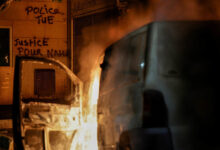
Agents seized 33 boxes holding more than 100 classified documents – plus many empty folders

Mar-A-Lago © Getty Images / Nathan Posner
Details of the contents of the 33 boxes of material seized from former US president Donald Trump’s Florida home last month were published on Friday by the Justice Department, adding some context to the shorter list released in the days following the raid.
The expanded inventory was released on order of US District Judge Aileen Cannon, ahead of deciding whether to appoint a special master to review the seized documents. Trump’s legal team has insisted many of the files are protected by executive or attorney-client privilege and demanded the return of any that don’t fall under the purview of the search warrant.
The warrant, based on an FBI affidavit alleging agents had repeatedly tried and failed to collect classified files from Mar-a-Lago by other means, was not particularly specific regarding what was to be seized, referring broadly to “physical documents and records constituting evidence, contraband, fruits of crime, or other items illegally possessed in violation” of federal law concerning the storage of sensitive material, including the Espionage Act and various presidential records laws.


Read more
While the nighttime raid yielded over 100 classified documents, the expanded inventory reveals it also turned up more pedestrian fare, including scores of empty folders bearing restricted markings, giving the impression of a more substantial haul than may actually exist. One box contained 99 newspaper and magazine clippings from 2017 and 2018 alongside seven “top secret” documents, 15 “secret” documents, 43 empty folders marked “classified,” and 28 empty folders marked “return to Staff Secretary / Miliary [sic] Aide.”
Classified documents were mixed into press clippings and other non-sensitive material seemingly haphazardly, according to the inventory. One box contained 68 press clippings from between 2015 and 2017, an “article of clothing or a gift,” a book, and two non-classified government documents, while another included 11 “confidential” papers and 21 marked as “secret” mixed in with 30 press clippings.
Still another held just two “classified” papers among 357 non-classified government documents and photos and 24 media clippings.
While prosecutors have framed the situation as one of deliberate potential “obstruction,” alleging the Trump team deliberately hid and removed classified documents to thwart federal agents seeking to return them to their rightful place in the National Archives, Trump has insisted his team was cooperating with the agency. The former president has also claimed there was a standing order to declassify any papers he brought home after leaving the presidency.




